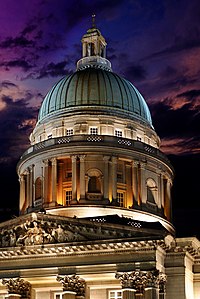Old Supreme Court Building, Singapore
| Supreme Court | |
|---|---|
 | |
 Location of Former Supreme Court in Singapore | |
| General information | |
| Status | Occupied |
| Type | Court |
| Architectural style | Baroque Revival, Neoclassical |
| Classification | B |
| Location | Singapore |
| Address | 1 St Andrew's Road, Singapore 178958 |
| Town or city | Singapore |
| Country | Singapore |
| Coordinates | Coordinates: 1°17′23″N 103°51′04.5″E / 1.28972°N 103.851250°E |
| Groundbreaking | 1 April 1937 |
| Construction started | April 1937 |
| Completed | 1939 |
| Opened | 3 August 1939 |
| Closed | 2011 |
| Affiliation | National Heritage Board |
| Technical details | |
| Floor area | 5,110 m2 (55,000 sq ft) |
| Design and construction | |
| Architect | |
| Architecture firm | Public Works Department |
| Other designers | Cavaliere Rudolfo Nolli Augusto Martelli |
| Main contractor | United Engineers |
| Designated | 14 February 1992 |
The Old Supreme Court Building (Malay: Bangunan Mahkamah Agung Lama, Chinese: 最高法院大厦) is the former courthouse of the Supreme Court of Singapore, before it moved out of the building and commenced operations in the new building on 20 June 2005. The building was the last structure in the style of classical architecture to be built in the former British colony. The building, together with the City Hall, has been converted into National Gallery Singapore which was opened in 2015.[1]
History[]


Many colonial-built houses were built before the courthouse was constructed in the 1930s, in addition to the Grand Hotel de l'Europe, which was demolished to make way for the new building. Raffles initially designated the site for public use, but his administrator in Singapore, William Farquhar, allowed private residences to be constructed there. By the 1830s, houses built in Madras chunam lined the streets that faced the sea. The residence of Edward Boustead designed by George Drumgoole Coleman stood there.
The house was remodeled to become hotels of several names, namely London Hotel, Hotel de l'Esperance and later Hotel de l'Europe. However, these houses made way for the Grand Hotel de l'Europe in 1900, the only other hotel in Singapore that could be comparable with the landmark Raffles Hotel. The Grand Hotel boasted a lounge, reading room, a bar, shops and a roof garden, a novelty at that time. In 1932, the hotel's business declined and filed for bankruptcy. It made way in 1936 for the present building, the former building had good views of the Padang from its verandah.
On 1 April 1937, the original foundation stone of the Old Supreme Court Building, (then the biggest foundation stone in the whole of Malaya) was laid by the Governor of the Straits Settlements,[2] Sir Shenton Whitelegge Thomas. Buried beneath the stone, is a time capsule containing six Singaporean newspapers dated 31 March 1937, and a handful of coins of the Straits Settlements. The capsule is not due to be retrieved until the year 3000.[2]
The building was declared open on 3 August 1939 by Sir Shenton Thomas and handed over to the Chief Justice, Sir Percy McElwaine, on the same day.[2]
The courthouse had 11 courtrooms and adjoining judges' chambers. In 1988, a further 12 courtrooms from the City Hall were transferred to the Supreme Court to accommodate the needs of the main courthouse, as it needed more courtrooms.
Engineer Frank Dorrington Ward's plan was to demolish the Singapore Cricket Club, Old Parliament House and the Victoria Theatre and Concert Hall to make way for a grand government scheme designed by his department. However, this plan was interrupted by the onset of World War II.
The building was the site of war crime trials of members of the Japanese Imperial Army in 1946 after the World War II.[3]
The Old Supreme Court Building, together with the adjacent City Hall, was converted into the National Gallery Singapore opened in 2015.[1]
Architecture and design[]

Built in front of the historical Padang grounds between 1937 and 1939, the Old Singapore Supreme Court building was designed by Frank Dorrington Ward, an engineer of the Public Works Department of Singapore, and was his last and most significant piece of work.
The former courthouse features Corinthian columns, classical design, and spacious interiors with murals by the Italian artists. The four-storey steel structure was erected by United Engineers. The building consists of four blocks surrounding a central courtyard which houses the circular law library with its significant dome and Travertine columns supporting two balconies on two levels. Behind the main dome, there is a smaller dome.
The pediment sculpture (an allegory of justice) which characterized the Supreme Court is a work by Florentine sculptor Augusto Martelli.
The Corinthian columns are works by Cavaliere Rudolfo Nolli. Nolli also carried works for the general building, pre-cast works, imitation stone sculptures, artistic decorations, special plastering and bush-hammered facing works.
See also[]
| Wikimedia Commons has media related to Old Supreme Court Building. |
- Supreme Court, Singapore
- City Hall MRT station
Notes[]
- Ho, Weng Hin (2008), The Former Supreme Court of Singapore & its Artificial Stone: Documentation, Analysis & Conservation Guidelines for a National Monument, Genoa: unpublished thesis, School of Specialization in Restoration of Monuments, University of Genoa, OCLC 233929838.
- History of Supreme Court
References[]
- ^ a b Whiteman, Hilary (26 November 2015). "National Gallery Singapore finds first home for unseen art". CNN.
- ^ a b c "AsiaExplorers - Visit, Discover & Enjoy Asia!". www.asiaexplorers.com. Archived from the original on 28 March 2015. Retrieved 31 March 2015.
- ^ Singapore, National Library Board. "Former Supreme Court building - Infopedia". eresources.nlb.gov.sg.
| Wikimedia Commons has media related to Allegory of Justice (Singapore). |
- Government buildings in Singapore
- National monuments of Singapore
- Tourist attractions in Singapore
- Government buildings completed in 1939
- Downtown Core (Singapore)
- Courthouses
